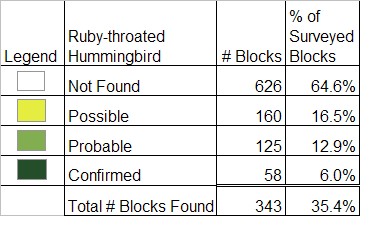Breeding Bird Atlases (BBA)
Find a Bird - BBA1
Breeding Bird Atlas 1 Species Accounts
Ruby-throated Hummingbird
Archilochus colubris
Egg Dates
late May to mid-August
Number of Broods
one or two

An unforgettable sight is the glimpse of a male Ruby-throated Hummingbird on a May morning, especially if he perches briefly, turning his head from side to side, his flame red gorget flashing brilliantly as it catches the light. Declining in numbers over the years in eastern Massachusetts with the maturation of the forests and the disappearance of orchards, this species is now an uncommon but widespread breeder in the state, nesting chiefly in less developed areas. It is most common in the Berkshires and foothills along the Connecticut River valley, with only sparse nesting on the Worcester County plateau. Fair numbers occur along the coastal plain, with the exception of Nantucket.
The males preceding the females, these spritelike birds leave the tropics in late winter, some of them flying 500 miles or more over the Gulf of Mexico, moving northward in pace with the opening flowers and typically arriving in Massachusetts in May. This species is a generally uncommon, although occasionally common, spring migrant, usually seen singly or in a group of two to five, but swarms of fifteen to twenty may gather to feed at a large flowering tree. In spring, these migrants move along the outer coast, skimming over the tops of grasses and shrubs close to the ground, and they are regularly sighted from boats at sea, the tiny birds flying rapidly along, often within the troughs of the waves to avoid strong winds.
Aptly named for the droning sound of its wings and for the male’s brilliant throat plumage, the Ruby-throated Hummingbird is one of the smallest members of the largest nonpasserine family. Tiny and beautiful, this species exhibits four prominent hummingbird features: a helicopterlike flight, a very high and variable metabolic rate, an attenuated bill with an extrudable tubular tongue, and a belligerent and aggressive character.
The courtship behavior of this hummingbird emphasizes its most adaptive proficiency—flight, rather than vocalization. In this species, vocalizations are limited to abrupt bursts of rapid chittering and squeaking, more useful in aggression and defense than in attracting a mate. The courtship dance is a pendulumlike flight in which the male swings back and forth in a 180 degree arc, rising 8 to 10 feet above and 5 to 6 feet to the side of a feeding female. Swooping toward her with wings and tail outspread, he creates a loud buzz within inches of her on each downswing. This continues for several seconds at a time and may be repeated every day for as long as a month until the female accepts the male. The male also performs a forward zigzag flight. Copulation occurs only 2 or 3 days before the eggs are laid. No lasting or even temporary pair bond is formed in this species, and the male departs after mating occurs.
The preferred nesting sites are in open woods, occasionally in dense forest or its margins, and in orchards or flower gardens. A variety of different species of trees may be utilized. Two Massachusetts nests were both in pines, and 1 of these was 40 feet up in a White Pine in deep woods (Nice 1933). The female selects the site (usually on a down-sloping, slender branch, often overhanging a stream), 5 to 50 feet above the ground, aggressively defends the area, and quickly (within 1 to 7 days) constructs the nest alone, utilizing bud scales, plant down, lichens, and spider silk. The minute (slightly over 1 inch in diameter), cup-shaped nest is secured to the branch with silk and festooned with bits of lichen so that it resembles a branch stub. The hummingbird is probably saved from parasitism by the cowbird, thanks to the small nest size. There is only one report of such parasitism, and the cowbird egg completely filled the tiny nest. Females have been observed gathering nesting materials on June 16 and June 24 (TC, Meservey).
Two eggs are laid, and nest construction is completed during the 14 to 16 days of incubation. One state nest contained two eggs on June 19 (DKW), and another held eggs on July 18 (Nice 1933). The pea-sized young are fed initially with nectar and tiny insects squirted into their mouths, but, as the bills of the young lengthen, the mother inserts the full length of her beak into an infant bird’s gullet and regurgitates the food. The young fledge in about three weeks, by which time they are fully feathered in juvenal plumage. Young males acquire a few ruby-colored throat feathers during August and September. There may be two broods a season. Three broods have been documented in some areas but not in Massachusetts. However, the female will readily renest if a nest is destroyed. Data on state nestling and fledgling dates are very scanty. Nestlings have been discovered in Massachusetts as late as August 24 and August 28. The latter were not quite two weeks old, indicating that hatching occurred in mid-August (EHF). Two fledglings were observed with a female in Charlton on July 31 and August 1 (Meservey).
Between late August and late September, particularly to avoid the first frosts, the Ruby-throated Hummingbirds depart from Massachusetts on a southwesterly course to return to their tropical wintering grounds. There are a number of late records, even into November, but these reports may refer to reverse migrants. The wintering grounds extend from the southern United States through Mexico to Central America.
Map Legend and Data Summary
Atlas 1 data collected from 1975-1979


Note: uncommon in forest openings and suburban areas where suitable nectar sources exist; commoner westward
Dorothy Rodwell Arvidson



